|
|
|
Christmas Bird Count in Boundary County provides
valuable information over the years |
|
January 14, 2016 |
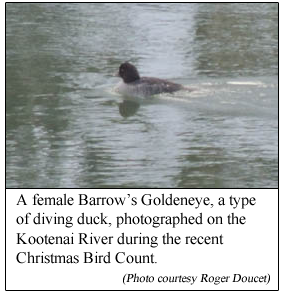 As the recent Christmas season in Boundary
County passes into fond memory, along with all
its events and activities—decorations,
nativities, Santa arriving at Georgia Mae Plaza,
caroling, and many others—we've got to mention
one more Christmastime event before we move
ahead in the new year: The Christmas Bird Count. As the recent Christmas season in Boundary
County passes into fond memory, along with all
its events and activities—decorations,
nativities, Santa arriving at Georgia Mae Plaza,
caroling, and many others—we've got to mention
one more Christmastime event before we move
ahead in the new year: The Christmas Bird Count.
The
Audubon Christmas Bird Count takes place
annually all over the world during the Christmas
season since it began 116 years ago back in
1900. This Christmas count has been going on in
Idaho since participation began in Moscow in
1914, and volunteers have been conducting
Christmas Bird Counts here in Boundary County
dating back to the 1980s.
The Christmas Bird Count can be thought of as
something a census count for birds in an area.
The data that are gathered here in Boundary
County are reported to the National Audubon
Society, and are compiled with data from around
the world. The information is then used by
ornithologists and other scientists as they
study a wide variety of issues, including
studies of local and migratory birds and
migratory patterns, the long term health and
status of bird populations, their ranges, how
bird populations have changed over the past
century, studies of the West Nile virus, climate
change, and other important studies.
"The Christmas Bird Count is the longest running
Citizen Science Project ever, and completely
done by volunteers," said Roger Doucet, who with
Kathy Konek are organizers of the Christmas Bird
Count here locally in Boundary County.
The Christmas Bird Count was conceived around
the turn of the 20th century by ornithologist
Frank M. Chapman, an officer in the early years
of the Audubon Society. The first "Christmas
Bird Census" was held on Christmas Day in 1900,
and 25 separate counts were held across the
continent in locations ranging from Toronto,
Ontario to Pacific Grove, California. The
tradition has continued and the Audubon Society
has conducted the annual Christmas Bird Count
during the Christmas season ever since.
"The annual Christmas Bird Count now takes place
all over the world," said Mr. Doucet, "including
the United States, Canada, Europe, South
America, and other areas during the roughly
three weeks from mid-December to early January
designated for the count."
Here in Boundary County, Christmas Bird Counts
were held beginning in the mid-1980s. It was
around that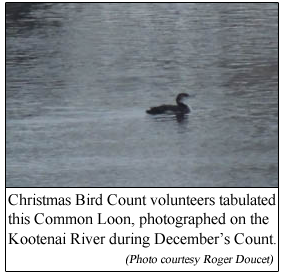 time
that a group of local residents got together and
formed the Bonners Ferry/Sandpoint Chapter of
the National Audubon Society. The group was
quite active for about 18 years, and one of
their annual activities was to hold a Christmas
Bird Count. That group eventually disbanded, but
members Jan Rose and David Siebenthaler
continued doing the Count for a few more years.
Eventually participation died out, and the
annual Christmas Count was discontinued. Later a
group from the Coeur d'Alene Chapter of the
Audubon Society took over the count. time
that a group of local residents got together and
formed the Bonners Ferry/Sandpoint Chapter of
the National Audubon Society. The group was
quite active for about 18 years, and one of
their annual activities was to hold a Christmas
Bird Count. That group eventually disbanded, but
members Jan Rose and David Siebenthaler
continued doing the Count for a few more years.
Eventually participation died out, and the
annual Christmas Count was discontinued. Later a
group from the Coeur d'Alene Chapter of the
Audubon Society took over the count.
In 2008, Jan Rose again got involved and became
the compiler for the local count for several
more years. For the recently completed 2015
Christmas Bird Count, Kathy Konek and Roger
Doucet took over responsibilities for the
project
Christmas Bird Counts now take place throughout
our region. Along with Boundary County, counts
are held each year in Coeur d'Alene, Sandpoint,
Moscow-Pullman, Lewiston, McCall, Spirit Lake,
and in Troy and Libby in Montana. Counts are
also held in Spokane and surrounding areas, and
beyond. Over 30 counts were held throughout
Idaho.
How does the Christmas Bird Count work here in
Boundary County? As in all areas where the count
is done, a 15 mile diameter counting circle is
selected. Here in Boundary County, the circle
used for the count is centered roughly at the
north end of downtown Bonners Ferry's Kootenai
Bridge. See the accompanying map for the
location of this counting circle.
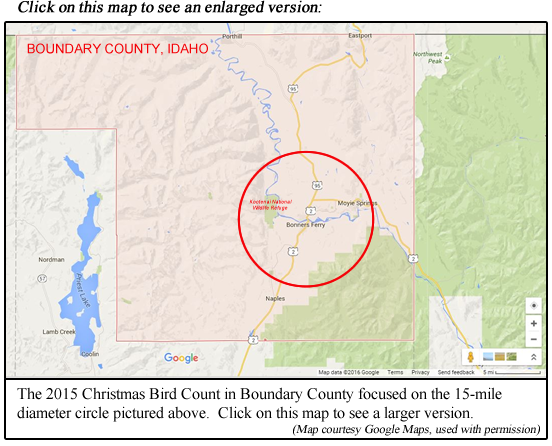
"Those who do the counting are volunteer birders
or others who want to learn, help out , or enjoy
the companionship of enjoying the outdoors and
doing something useful. Some stay home and count
birds seen at their feeders or in their yard. A
person does not have to be a member of Audubon
to lead, compile, or participate in the
Christmas Bird Count," said Mr. Doucet.
The volunteers participating in the count first
gather at a restaurant, where they divide into
groups, each group having maps, bird lists, and
forms to fill out listing miles driven, miles
walked, and the weather for the day. "They spend
the day observing," said Mr. Doucet, "counting
both the species of birds seen plus the number
of each species, then gather again at a
designated time at the end of the day to tally
results. Volunteers keeping track of the birds
that visit their birdfeeders can also send in
their results to the compilers if they are
located within the count circle."
Typically around 20 people participate in
Boundary County's counting. Five people
participated this year by counting birds at
their home bird feeders within the count circle.
What has been learned here locally in the
Boundary County Christmas Bird Count? According
to local counting tallies, 65 different species
of birds were seen and tabulated in Boundary
County for this year's count, which is the
highest number of different species ever counted
here. Over 9,000 individual birds were counted.
Mr. Doucet says the most commonly seen birds are
Mallards, Crows, Black-capped Chickadees,
Flickers, and Canada Geese. Over 5,000 Mallards
were seen in a field at the north end of the
Kootenai National Wildlife Refuge.
Unusual and rare birds are often seen on these
counts. For example, this year Horned Larks and
Rusty Blackbird were reported for the first
time.
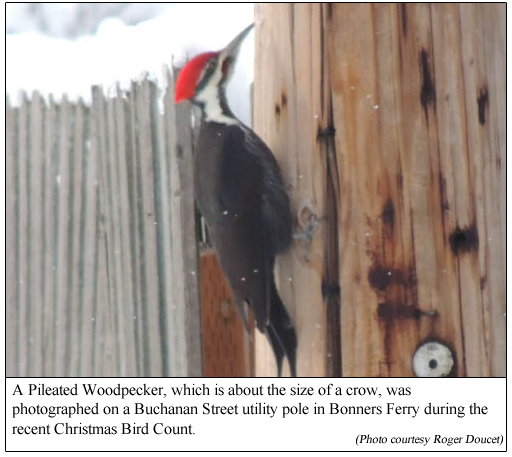
Over the years, changes and trends have been
noted in the bird counts in Boundary County.
"Some species that were never seen on the count
a few years ago, such as the eastern Blue Jay
and Eurasian Collared-Dove, are now seen on most
counts," said Mr. Doucet. "In the early days of
the Bonners Ferry Christmas Bird Counts back in
the 1980s, no Bald Eagles used to be observed.
Now the past many years show good numbers of
both adult and immature bald eagles. There used
to be no Double-crested Cormorants in the
county. They are now breeding in the county and
a few are wintering here as shown by the
Christmas Bird Counts."
On a nationwide basis, the Christmas Bird Count
showed the rapid decline of Evening Grosbeaks
across North America.
Thanks to those who take the time to participate
in the Christmas Bird Count, important
information on this particular aspect of
wildlife has been reliably compiled for both our
area here in Boundary County, nationwide, and in
many places around the world.
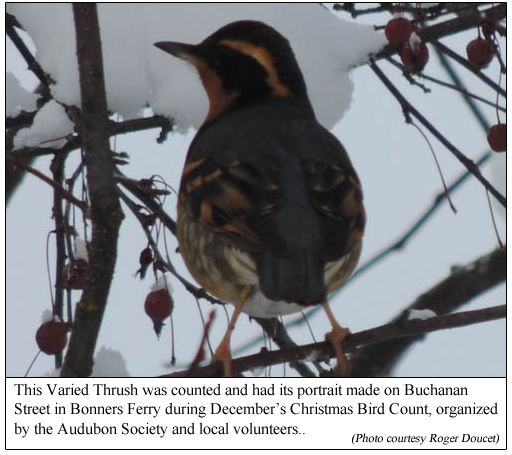
Any who has an interest in helping out and
contributing in gathering this important
information is invited to help out by
participating in the annual Christmas Bird
Count. Put it on your to-do calendar for next
December!
For more information, Mr. Doucet recommends the
following websites:
www.audubon.org/christmas-bird-count
www.idahobirds.net
www.ebird.org
www.audubon.org
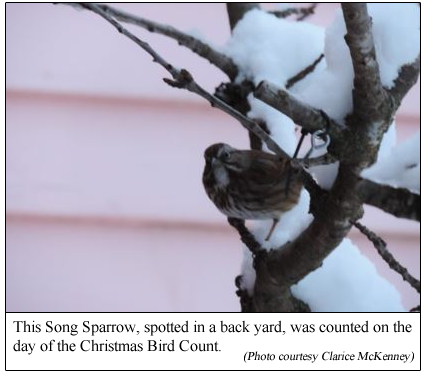
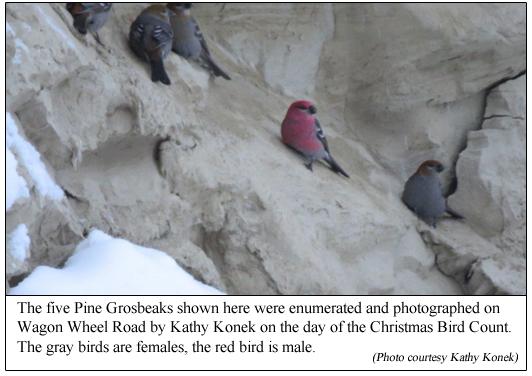
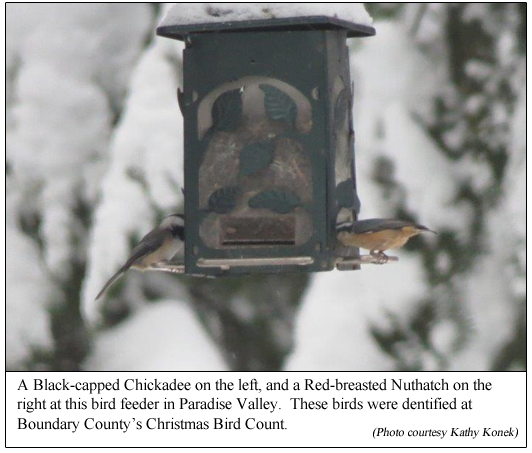
|
|
|
|
Questions or comments about this
article?
Click here to e-mail! |
|
|
|
|

